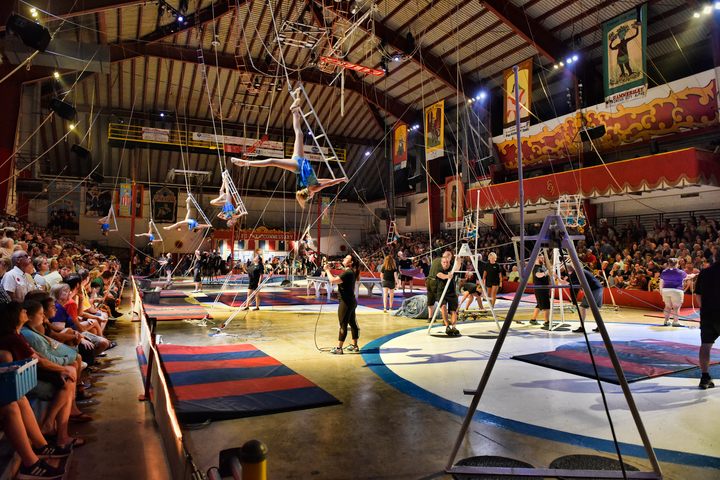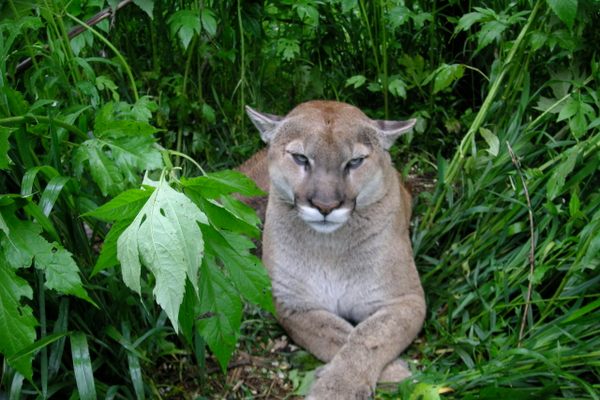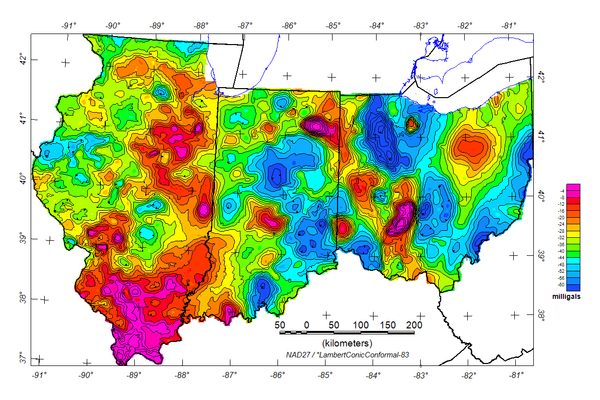
Inside the ‘Circus Capital of the World’
The big top came to Peru, Indiana, in the late 19th century. It never left.
Nostalgic slices of everyday Americana are served up in small towns across the nation, but few rival Peru, Indiana (population: 11,000) in cast and color. None are so steeped in the daring and willful trust of children flying through the air, ready to grasp the wrists of a teammate dangling upside-down from a trapeze bar, or balancing on the shoulders of a friend riding a unicycle across the high wire.
The circus doesn’t need to come to this town. It’s here every day, in the form of ongoing shows, historical remnants, and the blood of its residents.
Every July, Peru hosts an eight-day circus festival, culminating in a parade. (This story was reported in July 2019. As of today, circus training sessions have been canceled due to the COVID-19 pandemic, but Peru still hopes to host the festival in July 2020.) On parade day, music and cheers drift down Main Street. A human wave ripples the sidewalk as the crowd stands in the heat to honor the passing flag. Two helicopters sweep the route, signaling the start of the action.
Pat Kelly, son of the original hobo clown, waves to the crowd from a Volkswagen Beetle with a smile, despite the elaborate frown painted on his face. He wears a derby cap and patchwork tweed jacket, torn at the seams, just like his world famous father Emmett “Weary Willy” Kelly.

Horses prance down the street, pulling beautifully restored circus wagons stamped with names like Cole Brothers, Terrell Jacobs, Hagenbeck-Wallace, and Robinson Brothers. These names might not mean much to the mainstream, but in circus subculture, and within Peru’s city limits, they are royalty.
Peru got its first taste of the circus in 1884, when Civil War veteran and established livery owner Benjamin Wallace acquired a few rail cars worth of circus equipment and started his own show. It was called Wallace and Company’s Great World Menagerie, Grand International Mardi Gras, Highway Holiday Hidalgo and Alliance of Novelties. While the name wasn’t exactly catchy, the show proved successful. Wallace solidified his victory when he purchased the rights to the famous Hagenbeck Circus and rebranded as The Hagenbeck-Wallace Circus. Each spring the tour began in Peru with a parade featuring the circus band and exotic animal menagerie.

Circus troupes and acts like Buffalo Bill’s Wild West Show once lived like family at the Winter Quarters where Wallace kept his livery, just outside Peru along the Mississinewa River. Wallace built his village and painted every inch yellow, opening to his circus employees and animals in 1892. There were barns for the elephants and big cat standards, but also for ostriches, giraffes, camels, and even a hippo. There were equipment sheds, wagon shops, a clubhouse, and hospital. The community was quiet in the summer months, but every fall the railcars rolled in and circus migrants strode back through town toward the winter quarters to the tune of “Back Home Again in Indiana” streaming from the calliope.

Today one of the antique calliopes from those old circus days stops in front of downtown Peru’s permanent circus building, blaring its whistles in announcement of the annual show for all to hear. The town’s youth have been performing shows that rival their professional counterparts here every summer for the past 60 years.
Inside the circus building, senior ringmaster Bruce Embrey strolls through before the afternoon show. Embrey came to Peru early in his career as a judge, a post he held for 28 years before becoming the county prosecutor. He is coming up on his 40th year with the circus. “I came down here in 1981,” he says. “My daughter wanted to be in the circus, so I volunteered and I was a rigger. Right after the show they had a road show in Montpelier, Indiana and the two ringmasters couldn’t make it, so they asked me to do it. I’ve been doing it ever since.” He has since retired from his day job, but isn’t ready to give up his ringmaster whistle.

In the farthest ring, the hive-minded high wire troupe methodically works on rigging—raising the net and securing ladders and platforms. Kamon and Cassandra Blong are siblings in the act. Kamon led the world’s youngest six-person pyramid across the wire at age 13. Now 16, he explains how, seven years ago, his mother (a wire walker herself) pushed him to try out for the unconventional sport. “The first two years my mom forced me to do high wire,” he says. “I didn’t want to at all.” He has come to enjoy it.
At circus tryouts a few months ago, 10-year-old Cassandra got jitters just climbing the ladder to the high-wire platform. Today her braids bounce as she chatters with confidence despite being the team rookie. When asked if she is nervous she says, “Not really, I am used to it now.”

Before the show, some of the troupe ritualistically wills fears away with aromatic oils. But not Kamon—he doesn’t like the smell.
The Ringling brothers eventually took over the circus community in Peru, but took a big hit during the Great Depression. In 1941 the doors to the Winter Quarters closed for good, and to save space and minimize maintenance, they burned the old circus wagons, and the town’s history shriveled and smoldered. With the wagons up in smoke and no Winter Quarters to return to, there seemed to be a circus-shaped hole in the heart of Peru. Many circus folks found it hard to leave, so they joined the “normals,” as they called them, laying roots in Peru that are still growing today.
Back in the downtown circus building, Embrey’s wife delivers his ringmaster vest and he retreats to a small dressing room to collect his thoughts before the show. He breathes deeply and acknowledges his nerves. “They keep me sharp,” he says. He enters the arena wearing white gloves and a sparkling red jacket. He holds a single silver whistle, ready to cue the band. The show begins with the National Anthem, sung by Peru local, Shelly Ploss-Ostopa. She is the great-granddaughter of Clyde Beatty, who cleaned circus cages as a teen in the 1920s and went on to become a famous lion tamer. The crowd roars.

“The circus is 100 percent in my blood,” says Ploss-Ostopa, standing by the ticket counter after her performance. “It is something I just always wanted to do. This is home.” She is excited for her young son to become a fifth-generation performer. Although he is not yet a year old, she says he is already a circus buff.
In the 1950s, Bob Weaver, local art teacher and circus fan, campaigned for Peru’s Winter Quarters circus history to be recognized and celebrated. Out of this effort came the town’s Circus City Festival and accompanying Peru Amateur Circus, which celebrates 60 years in summer 2020. Performers in the early shows were all ages and trained by the retired circus professionals who stayed in Peru. Today performers are required to be county residents aged 7-21. Many come from circus families.

In the 1980s Embrey helped broker a deal to bring the International Circus Hall of Fame from Sarasota, Florida to the Winter Quarters in Peru, solidifying Peru as the Circus Capital of the World. The Winter Quarters were once again thriving, offering the public a glimpse of circus wagons and artifacts from all over the world, as well as professional Big Top shows each summer during Circus City Days. Currently, the professional shows are no longer running, and despite being added to the National Historic Register, the Winter Quarters and Circus Hall of Fame are desperate for repairs and attention.
The sold-out arena is dark, and with one shrill blast, Embrey’s whistle sends the band into an ominous opening number. The spotlight lands on Kamon Blong, who sits steady in a chair on the half-inch high wire, 25 feet in the air. He is calm but intensely focused as he moves to stand atop the chair, every muscle clenched to avoid that net.
In the next trick, Cassandra, light on her feet, rides the wire standing on the shoulders of a unicyclist. The band’s music merges with the scene, cresting as the single wheel reaches the end of the rope and Cassandra is pulled to the platform. The crowd cheers then quickly quiets again when Embrey announces the six-person pyramid led by Kamon. The only sound that cuts through the arena during this dangerous feat is the sharp command, “Step!” called at precise intervals by Corey Brockover, last in line. They reach the end safely and celebrate.
After the three-hour, talent-packed show, the full cast of nearly 200 parades the arena for the ninth straight day. Like those that once paraded back to the Winter Quarters every fall, these young performers call this place home and the people around them family. “We are teaching circus skills, but what we really are teaching are life skills,” says Embrey. World-famous markswoman Annie Oakley, the star of Buffalo Bill’s Wild West Show once said, “Aim at a high mark and you’ll hit it. No, not the first time, nor the second time. Maybe not the third. But keep on aiming and keep on shooting for only practice will make you perfect.” Today the young performers keep aiming for that high mark. Here they learn to meet fear on top of the wire or on any given day, and walk it calm and cool to the other side, one step at a time.








Follow us on Twitter to get the latest on the world's hidden wonders.
Like us on Facebook to get the latest on the world's hidden wonders.
Follow us on Twitter Like us on Facebook